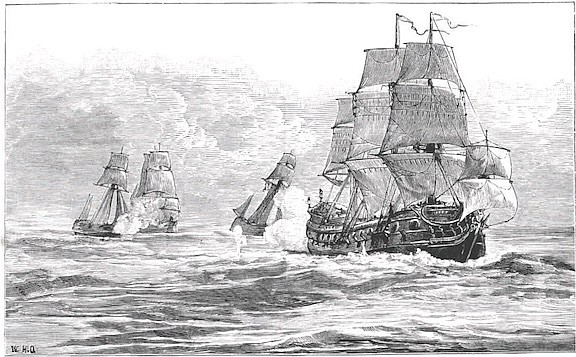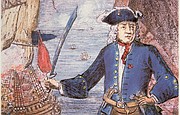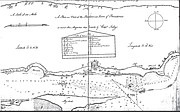TWO vessels were lost in Nassau harbour – one of them huge and famous, the other a tiny nameless rowboat whose loss is commemorated with a 20-foot stone tower on the country’s busiest street. The first vessel was known as The Fancy, and she was lost late in 1696 for political reasons, though in the world of privateers, pirates, and crooked governors, very little is verifiable. The story of this ship hinges on its captain, Henry Avery, born near Plymouth, England, to a fallen family. He joined the Royal Navy and rose to shocking prominence in May of 1694 at La Coruña Spain in a mutiny from which he emerged in command of a 46-gun Spanish warship (Charles II) under Captain Gibson.
The next few months were dizzying and demonstrated Avery’s duplicitousness. Renamed The Fancy he took the ship to a pirate kingdom in the Indian Ocean, careened it to make it much faster, made a crew of 150 men and alliances. First Avery overtook and captured a major French privateer, then banded with five pirate ships to attack a fabulously valuable treasure fleet. The 25 ships belonged to a Murghab or Arab king, going from the Red Sea to India. Avery won the battle and captured princesses, then spent days engrossed in torturing them, looting some £600,000. In August 1694 he slipped away for the Bahamas, skipping out with most of the loot.
So damaging was this to the East India Company that British parliament declared Avery hostis humani generis: an enemy of humanity. The Fancy landed at Royal Island west of Spanish Wells, in March of 1695, and Avery, under the fake name “Captain Bridgeman” sent an emissary to Governor Nicholas Trott, whose tenure had only begun the year before. He offered to bribe the governor, who was paid £300, with £850. Trott hadn’t seen the Royal Navy in years, and was facing capture by French who had just taken Exuma. So, he had the governing council welcome Avery and The Fancy, which anchored in Nassau.
At the time only about 27 men were able to defend New Providence; not enough to man the guns. Avery’s ruse was that he and his men were illegally trading slaves, however, when he did find slave traders, the Pirate Museum of Nassau, says he captured the traders and “sold” them to slaves! In the hold of The Fancy, the inhabitants found incredible assets, including 50 tons of elephant tusk, foreign coins, many cannons, and barrels of gunpowder. Of course, Trott denied knowing that Bridgeman was Avery. The very sleepiness of New Providence, with so few people to entertain such wealthy pirates played to Governor Trott’s favour. Soon Avery and his colleagues slipped back to England aboard ships named Isaac, and to Ireland aboard the Sea Flower, under Captain Faro, which was intercepted while landing treasure. Once again Henry Avery escaped and vanished, dying in obscurity.
What of The Fancy, one of the most successful pirate ships ever? In his book The Pirates’ Pact, Douglas Burgess states his view that “Trott had stripped Fancy of everything valuable, and it was lost after being violently driven against some rocks, perhaps deliberately on the orders of Trott, who was eager to rid himself of a key piece of evidence.” While difficult to ascertain – after all, we still don’t know where in Nassau Governor Woodes Rogers is buried, it was known to be in Nassau, abandoned in a hurry. Given that it was one of the most sought-after ships in the world, it is plausible that it never left Nassau. Sunken ships can be silent ships, even at the doorstep of a colony’s capital.
In fact, The Fancy is believed to have wrecked at what is now Hurricane Hole Marina, under the original Paradise Island Bridge. Old clay pipes dating from the late-1600s have been found there, and apparently when the marina was expanded, pilings were driven right through the timbers, some of which may be extant, even today…
Most readers will have passed the spot along West Bay Street opposite the Road Traffic Department and Bahamas Girl Guides many times. For 160 years, an obelisk 15 feet tall and 20 feet above the road has quietly kept vigil over the spot where five men died trying to save two others. All of them were in boats, and all were tackling the gargantuan waves curling over the bar protecting the entrance to Nassau Harbour. This is their story.
Thirty feet from Bay Street in the direction of the first fish-fry shacks at Arawak Cay, stands the monument constructed of limestone block, installed in 1861 to commemorate the heroism of five Bahamian men who gave their lives on a rescue mission. On Tuesday, 26 February 1861 the “two men drifted from Nassau Harbour in a boat;” believed to be a pilot boat. Their cries for help were heard by a hardy group of volunteers on shore. Their names were Issac Knowles, Felix Buby, Joseph Henry Strachan, Thomas Edden, and Joshua Edwards, and they soon set out in their own overcrowded little vessel.
Pilot boats and the folks who operate them are not ordinary. Throughout their long history, these boats have resembled the men and women who venture out to meet ships: fast, sturdy, and aggressive. “Used to transport maritime pilots between land and the inbound or outbound ships, pilot boats were once sailing boats that had to be fast, because the first to reach an incoming ship got the business.” If pilots and ship masters waited for calm weather to approach port, few supplies and people would ever reach land; the transfer is risky, dangerous, and often fatal.
This inscription dedicates the obelisk “in memory of [the five men] who perished on the Bar of Nassau Harbour whilst gallantly volunteering their services in the effort to save two men belonging to the Pilot-Boat which had been upset by a heavy sea.” In the ten months remaining of the same year, the Bahamas Legislature erected this obelisk to commemorate “their gallant conduct and self-sacrificial heroism.” The monument commemorates men drowned trying to prevent others from drowning, giving the rest of us much to contemplate while about our daily business from Bay Street or the Western Esplanade.








Comments
truetruebahamian 2 months ago
Well written and appreciated.
Sign in to comment
Or login with:
OpenID